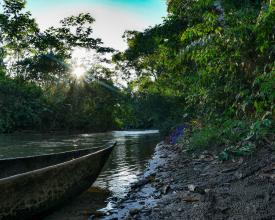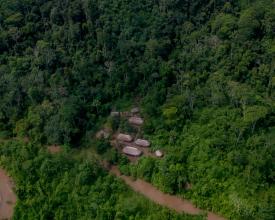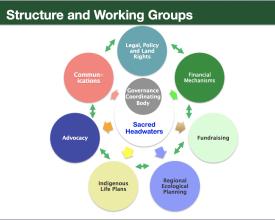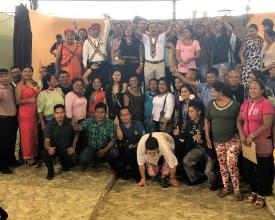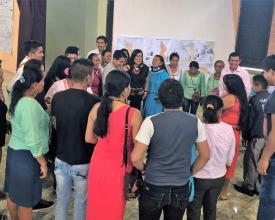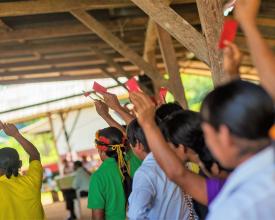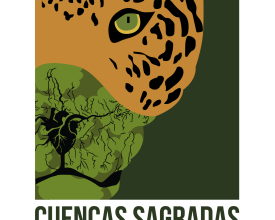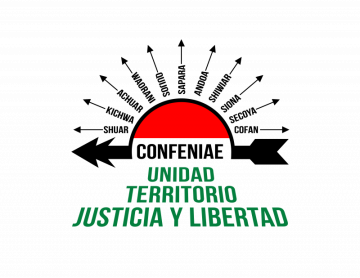
Sacred Headwaters of the Amazon
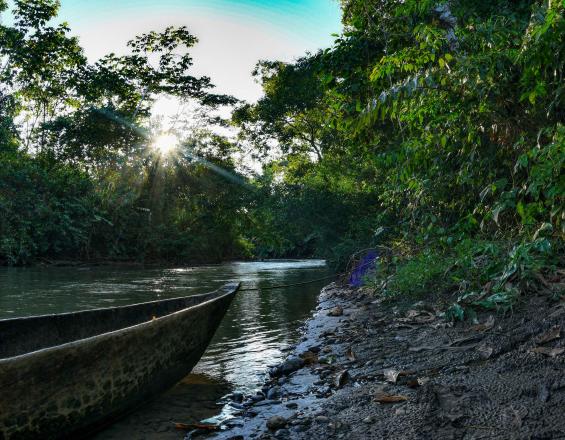
With a rights-based approach and working in close partnership with the region’s indigenous peoples and federations, the Amazon Sacred Headwaters Initiative seeks to establish a bio-cultural sanctuary in the heart of the Napo-Marañon watersheds. In Ecuador and Peru, indigenous organizations have declared their territories as “No-Go Zones” for industrial-scale resource extraction and where indigenous co-governance, alternative well-being indicators, and all activities are judged by the extent to which they foster a mutually enhancing human-Earth relationship.
Here, the ancestral territories of more than a dozen indigenous nations are adjoined by a number of protected areas, together forming a vast contiguous mosaic containing the most biologically diverse terrestrial ecosystem on Earth. These rainforests are critical carbon sinks and help to stabilize our global climate and rainfall and yet, they are facing a chronic and ever increasing risk from extractive industries.
Context
Challenges addressed
The role of indigenous territories and protected areas in maintaining the Sacred Headwaters region’s ecological integrity is both critical and at risk. Currently, the governments of Peru and Ecuador are in the process of granting drilling rights to nearly 22 million acres of mostly roadless areas within the headwaters region, on land legally titled to indigenous peoples and in protected areas such as the Yasuni National Park. In Peru, the government revived the process for approving oil production in the massive Block 64, which overlaps the Achuar's ancestral lands.
Other threats to the Napo-Marañon basin include a network of roads, oil palm plantations, and logging operations, which typically follow in the path of oil and gas development. Oil exploration, extraction, and transportation have severe ecological and human health impacts, as has been tragically seen in the Amazonian communities, where Chevron, previously Texaco, left a devastating legacy of toxic pollution.
Location
Process
Summary of the process
Led by a Steering Committee comprised of Fundación Pachamam, Pachamama Alliance, Amazon Watch, and the indigenous federations CONFENIAE (Ecuador) and AIDESEP (Peru), an estimated two-year period is envisioned for the initial development phase of the Initiative that includes five interrelated tracks:
1. Convene the indigenous nationalities of the region to forge a shared vision for the future of the headwaters region; build alliances; and strengthen their capacity to protect their territories;
2. Conduct research into (a) relevant regional ecological/scientific planning models and frameworks; and (b) strategies and options for long-term funding for the Initiative;
3. Develop and advance the international visibility (the brand) of the Amazon Sacred Headwaters region and build the corresponding support network for the Initiative;
4. Engage key industries, civil society, scientific/academic institutions and governments in the deliberation of alternative economic scenarios that also ensure the region's ecological integrity;
5. Intervene to stop new and imminent oil drilling and mineral mining in the region.
Building Blocks
Bioregional Alliance of Indigenous Peoples
The Initiative aims to support ecosystem-based and indigenous-led governance of this vast region and to secure stronger territorial rights. While historically, indigenous peoples had conflicts over territorial boundaries and still do at times, in the past two decades the region’s indigenous peoples have formed strong alliances to confront outside threats. This initiative seeks to unite indigenous peoples and strengthen alliances throughout the entire Napo-Marañon River Basins, expanding their collective purview to the larger bioregion. Viewing the strategy for protecting this region from the perspective of the entire river basin presents compelling and strategic opportunities to more effectively address regional threats brought by oil projects, dams, mining, and roads as well as to enhance the ecological and landscape connectivity.
As co-facilitators of this planning and alliance building process, Amazon Watch, Pachamama Alliance, and Terra Mater will work to ensure meaningful participation of affected indigenous peoples at all stages of this initiative.
Enabling factors
- Participatory strategic planning process, bringing together indigenous organizations of the Napo-Marañon region to articulate and adopt a shared vision
- Bi-National Convergence of Indigenous Peoples of the Napo-Marañon Basins of both Peru and Ecuador with their allies
- Sub-regional gatherings and workshops for the Napo, Pastaza, Morona Santiago, Alto Marañon, Pastaza/Corrientes regions.
- Indigenous life plans guiding the agendas of the subnational gatherings.
Lesson learned
- The promotion of the Sacred Headwaters Inititiave a the political proposal from CONFENIAE to protect their territories, based on the collective rights of indigenous peoples from the Amazon, has been a core aspect in the initial success of the activities planned.
- Having an achuar indigenous leader working within CONFENIAE, as the Ecuador Coordinator to expand awareness about the potential for such an initiative to build an alliance among the indigenous nationalities of the Napo-Marañon-Pastaza river basins in Ecuador and in Peru, has also been crucial.
- Numerous presentations and discussions about the Initiative have been conducted at indigenous assemblies in Ecuador’s Amazon region. In addition, the Initiative was also presented at the Achuar congress in Ecuador, at the Pan Amazon Forum in Tarapoto, at the bi-national Achuar Congress in Peru, and in all cases preliminary response to the Initiative has been very positive.
Resources
Sustainable territorial planning for the region
The Ecological Planning Working Group of the Initiative will conduct research, analysis, and surveys, and facilitate indigenous peoples' own bio-cultural mapping. Mapping provides geospatial analysis for planning at the larger landscape scales. Compiling and integrating layers of information such as pending indigenous lands claims, industrial threats, wildlife corridors, hunting grounds, protection status, ecosystem types and biodiversity data, population data, access routes, and fluvial links helps the alliance establish priorities and make sound governance decisions. In addition, such biocultural mapping is a key aspect of storytelling.
- Work will be carried out and guided by indigenous leaders and technical teams to weave together a tapestry of indigenous life plans, further flesh out implementation and find emergent threads. Examples of potential emergent threads include developing capacity for implementing self-reliant renewable energy and/or transportation systems; training and coordination for watershed restoration and water quality management; and establishing a regional hub for incubating and innovating solutions.
Enabling factors
- Engage academic sector
- Conduct research focusing on solutions and alternatives to current growth-focused economic models that are based on export-driven resource extraction industries and that instead focus on alternative indicators of wellbeing
- Exploration of models of indigenous co-governance in other parts of the Amazon or the world
Lesson learned
Indigenous life plans respond to a development vision of the indigenous territories so it is important to ensure its implementation, respecting the particularities of each community and each indigenous group. These natural resource plans are created through collaborative decision-making, and provide tools for self-governance and participatory management that harness the collective wisdom of the community.
An initial process of gathering all the indigenous life plans has started since last year. However, various indigenous groups need financial resources to update their life plans.
Visibility of the Amazon Sacred Headwaters
The purpose of the communications group is to make the Initiative favorably viewed in public opinion polls in Ecuador and Peru; to have opinion leaders, scientists, ministers and key political leaders in both countries publicly declare their support for the Initiative and their opposition to expanding mining and oil activities; to obtain significant stories in both countries’ mainstream media and on social media; and to achieve international visibility in social media and conservation/environmental publications and networks, and among private and public conservation foundations and funding institutions.
Enabling factors
- Develop a communications plan to popularize the global importance of the bioregion – producing compelling, interactive maps based on scientific information, and visual content, and use storytelling and media campaigns to build public support for the Initiative.
- Organize and mobilize opinion leaders, journalists, influencer networks, celebrities, scientists, and academics in support of the Initiative.
- Expand capacity building in media skills training for indigenous leaders to support their own storytelling and advocacy.
Lesson learned
It would be crucial to generate debate and amplify the importance of indigenous climate solutions; biodiversity of the region; ecological functions of the Amazon; protection of sacred areas; development models not based on extracting fossil fuels and minerals; clean energy; and mitigating climate change.
Engagement of key stakeholders
Through a participatory multi-stakeholder regional planning process that includes government and civil society, the Amazon Sacred Headwaters Initiative will develop and publicly present a compelling plan backed with rigorous analysis for protecting the region's unparalleled biological and cultural wealth as a pathway for Ecuador and Peru to meet their countries’ development needs while also leading the inevitable economic transition beyond dependence on fossil fuels and towards an ecological civilization.
Enabling factors
- The national governments of Ecuador and Peru, as well as local provincial, departmental and municipal governments, will be key stakeholders in the process of moving this vision forward and will need to be engaged accordingly.
- High level dialogues and global advocacy
Lesson learned
The process will look to lessons from other similar examples of successful multi-stakeholder processes and challenge the meta-narrative that more resource extraction alleviates poverty.
We will build upon the 2016 resolution adopted by the IUCN, calling for the protection of sacred natural areas free from industrial extraction as a way to advance protection for the Sacred Headwaters. We will be working with the IUCN to advance the implementation of this resolution in the lead up to the next World Conservation Congress in China in 2019-2020
Respond to imminent territorial threats
Intervene to stop imminent industrial extraction threats, including existing and proposed oil and mining concessions, and territorial rights rollbacks, via both legal and policy arenas and an international markets campaign.
Given immediate threats from the current round of oil and mining leases, we will continue to scale up existing work to address urgent threats while developing this longer-term strategy.
Enabling factors
- Support local, national and international strategies to halt the expansion of extractive industries and challenge the present model of development.
- Continue to support national and international legal proceedings (UN, OAS’ Inter-American Human Rights Court) to hold governments and the oil/mining industries accountable for violating territorial rights and environmental laws.
Lesson learned
Our work in Ecuador has been instrumental in the ability of indigenous communities throughout the Amazon region to effectively defend their rights, as evidenced by historic legal cases, and illegal acts including:
- The 2011 ruling against Chevron Texaco that awarded $9.5 billion in reparations for the cleanup of 18 billion gallons of oil contamination in the rainforest
- A victory in the Inter-American Court of Human Rights that ruled that the State of Ecuador was responsible for violating the rights of the indigenous Kichwa people of Sarayaku by initiating oil development in their territory without first executing free, prior, and informed consultation with the community.
- The Condor-Mirador Mine Case that affects 25,000 acres in biodiverse tropical forest of the Condor Highland that included indigenous territory
- Failure of Ecuador’s government to obtain free, prior and informed consultation from indigenous communities prior to the XI Oil Round auctioning off ten million acres that encompass indigenous territory in the south-central region of the Amazon
Impacts
Fundación Pachamama, since 1997, has worked together with indigenous organizations of Ecuador's Amazon to defend their rights and their homelands. Millions of acres of pristine rainforest have been protected from oil development and deforestation. We have supported the mapping, titling, and participatory census of indigenous territories, and have worked with these communities on natural resource management planning and climate change policies. We also have promoted the implementation of natural resource plans, created through collaborative decision-making, and provide tools for self-governance and participatory management that harnesses the collective wisdom of the community.
Currently, Amazonian indigenous organizations CONFENIAE (Ecuador) and AIDESEP (Peru) together with Amazon Watch, Pachamama Alliance, and Fundación Pachamama are implementing an initiative aimed at permanently protecting 60 million acres of tropical rainforests in the Napo, Pastaza, and Marañon River Basins.
Beneficiaries
The SHW region forms a large mosaic of indigenous territories national parks and protected areas. The indigenous nations include the Waorani, Kichwa, Sápara, Achuar, Shuar/Wampis/Awajun, Shiwiar, Andoas, Candoshi, Cocama, among others.
Sustainable Development Goals
Story

Researchers confirm that in the Amazon basin, strategies to legally recognize indigenous peoples' land rights and support traditional community-based forest stewardship practices are more effective in conserving rainforests than establishing protected areas, such as National Parks, which are wholly managed by federal governments.
Case in point: While the government of Ecuador began drilling for oil beneath Yasuni National Park in 2016 despite widespread public outcry, it has been unable to commence any drilling in the nearby territories of the Sarayaku and Sápara peoples despite nearly 20 years of official, state sanctioned attempts to do so. In both cases, the government retains the subsurface mineral rights; yet indigenous territorial rights, and steadfast and skillful resistance have held more sway than ‘protected’ national park designations.
In Ecuador, one of the most important cases of territorial defense of indigenous peoples is the Sarayaku case. in 2012, the Inter-American Court of Human Rights issued its ruling in the case, stating that the State of Ecuador was responsible for not having previously executed free, prior, and informed consultation with the indigenous community of Sarayaku, in accordance with international standards. The Court found the State responsible for violating rights of the community of Sarayaku, their ancestral lands and cultural identity, for not granting effective legal protection, and for having placed their life and personal integrity in danger in the presence of seismic explosives within their territory.
Over the past two decades, indigenous peoples throughout this region have been relentless and for the most part successful in keeping out extractive industries. Even so, the current barrage of destructive projects including mining is unprecedented, each one requiring significant resistance efforts. The indigenous movement is spread thin. There is a realization that the stakes are higher now than they have ever been and that fighting one battle at a time will not be enough. The ecological integrity of the entire Napo-Marañon river basin is jeopardized with each new oil or mining project. Pollution and deforestation upstream affects all communities of life downstream.

